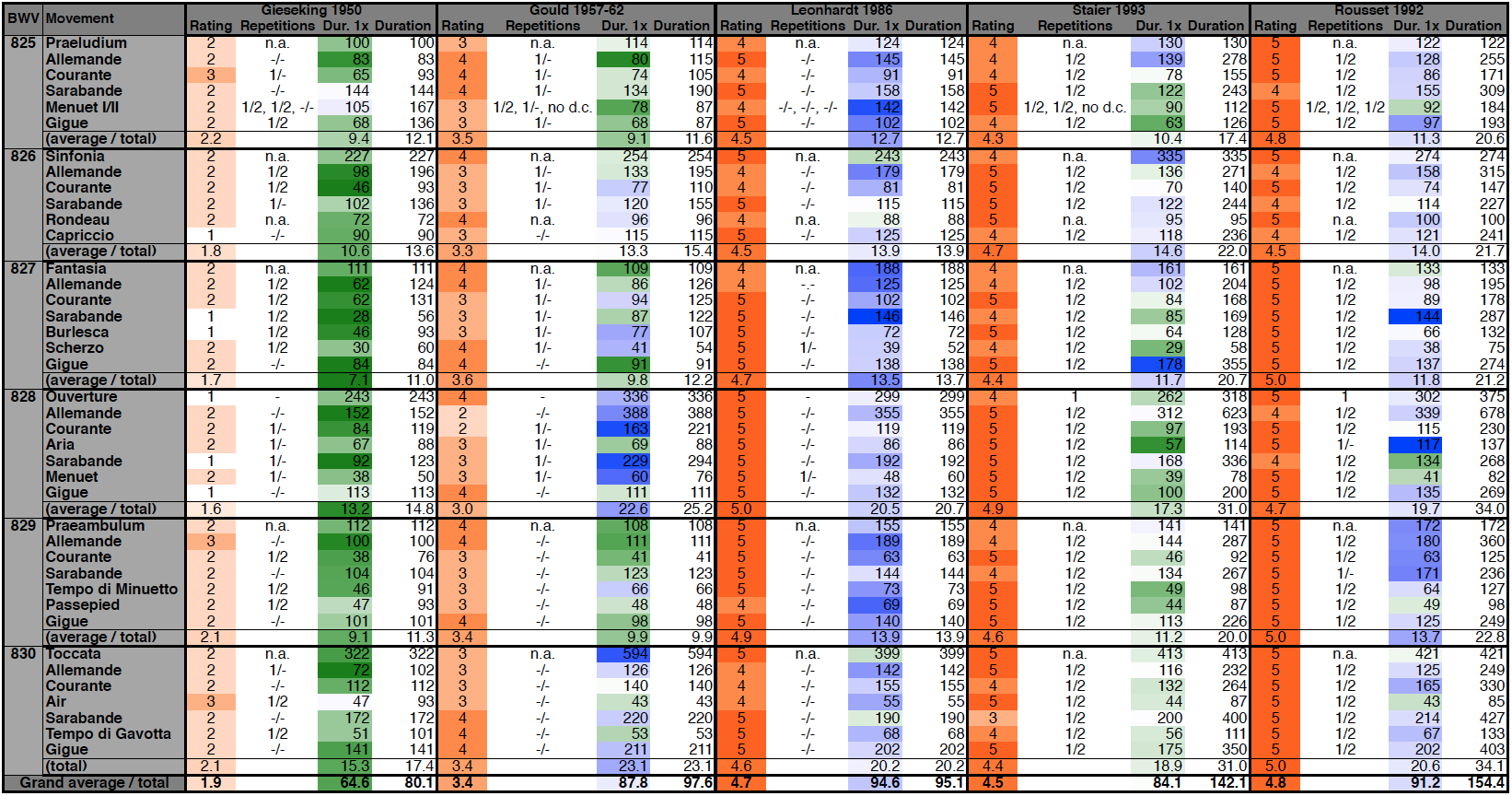Johann Sebastian Bach: 6 Partitas BWV 825 – 830
Media Review / Comparison
2013-12-12 — Original posting (on Blogger)
2014-11-10 — Re-posting as is (WordPress)
2016-07-14 — Brushed up for better readability
Table of Contents
The Recordings
Walter Gieseking, Piano (1950)
Johann Sebastian Bach: Six Partitas and other keyboard works
Partitas BWV 825-830; English Suite #6 BWV 911; Fantasy & Fugue BWV 906 & BWV 944; Toccata BWV 911; French Overture BWV 831; Italian Concerto BWV 971
Walter Gieseking, Piano
Music & Arts CD 947 (2 CDs, mono); ℗ 1996 / © 2005

Glenn Gould, Piano (1957 – 1962)
Johann Sebastian Bach: French Suites BWV 812 – 817, Overture in the French Style BWV 831
Glenn Gould, Piano
Sony Classical SM2K 52 609 (2 CDs, stereo); ℗ 1973/74 / © 1994

Andreas Staier, Harpsichord (1993)
Johann Sebastian Bach: Fantasias & Fugues BWV 894, 901-903, 904, 906, 917, 919, 921-922; Clavier-Übung I & II (6 Partitas BWV 825-830, Italian Concerto, BWV 971, French Overture BWV 831)
Andreas Staier, Harpsichord
harmonia mundi / BMG classics 82876 67378 2 (4 CDs, stereo); ℗ 1989-1994 / © 2005

Gustav Leonhardt, Harpsichord (1986)
Johann Sebastian Bach: Six Partitas BWV 825-830
Gustav Leonhardt, Harpsichord
Veritas x2 / Virgin Classics 5 62337 2 (2 CDs, stereo); ℗ 1987 / © 2004

Christophe Rousset, Harpsichord (1992)
Johann Sebastian Bach: Goldberg Variations BWV 988, Italian Concerto BWV 971, French Ouverture BWV 831, Chromatic Fantasy & Fugue BWV 903, 6 Partitas BWV 825-830, 4 Duetti BWV 802-805
Christophe Rousset, Harpsichord
Decca 475 7079 (4 CDs, stereo); ℗ 1992-95 / © 2005

On the Partitas BWV 825 – 830 by Johann Sebastian Bach (1685 – 1750):
With the exception of the second Partita, Bach’s six Partitas BWV 825 – 830 all follow the traditional Suite scheme:
Allemande (even) — Courante (in 3) — Sarabande (3/4) — Gigue
The second Partita features a Capriccio in lieu of a Gigue. All Partitas add an introductory movement, plus one or two extra movements after the Sarabande and/or after the Courante:
Partita Nr.1 in B♭ major, BWV 825:
Praeludium (4/4) — Allemande (4/4) — Courante (3/4) —
Sarabande (3/4) — Menuet I/II (3/4) — Gigue (4/4)
Partita Nr.2 in C minor, BWV 826:
Sinfonia (4/4 – 4/4 – 3/4) — Allemande (2/2) — Courante (3/2) —
Sarabande (3/4) — Rondeau (3/8) — Capriccio (2/4)
Partita Nr.3 in A minor, BWV 827:
Fantasia (3/8) — Allemande (4/4) — Courante (3/4) —
Sarabande (3/4) — Burlesca (3/4) — Scherzo (2/4) — Gigue (12/8)
Partita Nr.4 in D major, BWV 828:
Ouverture (2/2 – 9/8) — Allemande (4/4) — Courante (3/2) — Aria (2/4) —
Sarabande (3/4) — Menuet (3/4) — Gigue (9/16)
Partita Nr.5 in G major, BWV 829:
Praeambulum (3/4) — Allemande (4/4) — Courante (3/8) —
Sarabande (3/4) — Tempo di Minuetto (3/4) — Passepied (3/8) — Gigue (6/8)
Partita Nr.6 in E minor, BWV 830:
Toccata (2/2) — Allemande (4/4) — Courante (3/8) — Air (2/2) —
Sarabande (3/4) — Tempo di Gavotta (2/2) — Gigue (2/1)
Peculiarities in Form
The Ouverture (in BWV 828) is in the form of a French Overture, with a (double) punctuated, slow introduction, followed by a faster fugato part. The Sinfonia (BWV 826) is similar, but in three parts:
Grave, Adagio (4/4, punctuated) — Andante (4/4) — [fugato] (3/4)
Also the Toccata (in BWV 830) is in 3 parts, but without formal dividers or explicit tempo annotations: the piece starts with an introduction that switches between free parts in a style that Buxtehude used to call “stylus phantasticus” and metric sections; the central part is a three-part fugue, and the piece ends with another 20 bars in the “stylus phantasticus” from the first bars, this time without the “metric” sections. Neither Walter Gieseking nor Glenn Gould really expose the “stylus phantasticus” aspect in the Toccata.
Overview Comparison
This is a short review for a fair amount of music (9.5 hours altogether!): I have listened through Bach’s six Partitas not too long ago — the sole reason for re-listening now was the addition of the recording above with Christophe Rousset. Let me start with a table that summarizes my findings and informs about the relative tempo in the above interpretations (click to enlarge):

Explanations:
- the “Rating” columns list my (subjective) rating (1 – 5 points), for each of the partitas, there is the average over that composition, and the last row lists the overall, average rating. The color density indicates the rating.
- the durations are not directly comparable, because the recordings offer a wild mix of repeats vs. non-repeats; the column “Repetitions” indicates which repeats are performed:
- 1/2 means that both parts of a movement are repeated,
- 1/- means only the first part is repeated,
- -/- means no repeats at all
- “n.a.” indicates a movement without repeat signs
- “no d.c.” (in Menuet I/II in BWV 825) indicates that after Menuet II, Menuet I (da Capo) is not played again
- the columns “Durations” indicate the actual track duration — all in seconds, except for the summary line for each composition, as well as in the last row, where the duration is given in minutes.
- finally, the columns “Dur. 1x” list the (actual or hypothetical) track duration without any repeats (but with the da Capo in Menuet I/II in BWV 825), again in seconds for the individual tracks, and in minutes for the summary lines. Color coding was used to indicate the relative duration:
- green stands for short / faster than average
- white would be the average duration / tempo
- blue stands for long / slower than average tracks
Comments on the Interpretations
I do not mean to compare piano and harpsichord interpretations — occasional cross-mentions are meant as reference only, not as rating in any way; I don’t think one should play one against the other.
Walter Gieseking
For general remarks on this recording set by Walter Gieseking see my earlier post; the Partitas were recorded in 1950. At least from today’s perspective, Gieseking’s Bach often sounds rushed, superficial, if not careless, especially in the details. Even his pupils who were present at this recording (all done in a single session, without any repeats, all from memory, of course, and probably without any real rehearsal / preparation) felt that he was playing unusually fast. His selection of repeats vs. non-repeats looks arbitrary. The table above shows that with very few exceptions he is substantially faster than the other artists. That goes in hand with a rapid / rushed and superficial execution of any ornaments and fast passages in general.
Partita Nr.1 in B♭ major, BWV 825
The Praeludium is rushed, especially in the ornaments; the Allemande is played with strange accelerando, with superficialities. The Sarabande does not sound like Bach at all — it lacks tension, the ornaments are completely static. In Menuet II, all appoggiaturas are played as acciaccaturas, and rather careless, the Menuet I da capo is omitted entirely. In the Gigue, the articulation is static and lacks differentiation, and of course, the repeats are not differentiated either.
Partita Nr.2 in C minor, BWV 826
In the Sinfonia, the fugue is superficial, way too fast. the same holds true for the Allemande, where Gieseking loses tempo control, the piece often “runs away”. The Sarabande tends to be boring here, with its constant legato. The Rondeau is superficial, the Capriccio even more so.
Partita Nr.3 in A minor, BWV 827
The Sarabande isn’t — much too fast! Burlesca: superficial. Gigue: careless, should be in 12/8, but is played like 4/4, if not alla breve!
Partita Nr.4 in D major, BWV 828
The Ouverture is very superficial, especially in the ornaments. The Allemande to me does not sound baroque, rather like an early classic piece, again superficial in the ornaments. The Sarabande is an Andantino at best, almost an Allegro, totally missing the character of the movement.
Partita Nr.5 in G major, BWV 829
Too fast, rushed, superficial almost throughout, e.g., in the Praeambulum, in the Allemande (the latter isn’t really an Allemande this way!), the Courante, etc. — Gieseking runs through this composition (playing all the very nice little details) in half the time that Rousset takes!
Partita Nr.6 in E minor, BWV 830
Bad tempo control throughout the Toccata (the piece appears to run away frequently). The Allemande is way too fast — sounds rather like a Gigue! Also the Courante appears OK at first, but then, the ornamented parts reveal that this tempo does not allow playing out, let alone hearing any detail. The Sarabande sounds like a Menuet, and the final Gigue is again way too fast, the semiquavers sound like hastily performed acciaccaturas.
Overall rating: 1.9 — can hardly be recommended!
Glenn Gould
This is one of Gould’s early recordings, from 1962. 30 out of 40 tracks are stereo, in BWV 829 and 830, all but the first and last movements are mono only. These are Gould’s first stereo recordings, and the last two Partitas were recorded both in mono and in stereo. Unfortunately, the stereo tapes for 10 of the tracks appear to be lost. In the first four Partitas Gould plays most of the first repeats, only in Menuet I in BWV 825 he plays both repeats. That appears to be the substitute for a da Capo in that pair of Menuets. In the last two Partitas, none of the repeats is played (it is possible that more repeats were included in the lost stereo tracks).
Gould’s tempi are extreme almost throughout. There are some tracks where he is faster even than Gieseking, in other movements (most of BWV 828, Toccata in BWV 830) he is slower than anybody else. Nevertheless, he articulates meticulously, as always. His (intellectual and musical) focus is on exhibiting a piece’s melodic, harmonic, rhythmic and polyphonic structure / texture. His approach is a very interesting one — and in my opinion vastly more successful in baroque music than in compositions from the classical period. Still, this can hardly be compared to performances on a harpsichord — but within performances on the modern piano, I definitely prefer Gould’s “radical” approach over artists who overload such music with an excess of rubato and dynamic “features”.
Partita Nr.1 in B♭ major, BWV 825
The Praeludium noticeably loses tension and tempo, towards the end he picks up tempo again in order to be able to a final rallentando — neither of which is really needed, I think. The Allemande is too fast for that type of dance movement, though very well-played, technically; excellent playing again in the Courante — Gould is making this very transparent, exhibiting the polyphonic structure, but he does not leave room for a real “dance feeling” (lacking swing / intra-bar rhythmic tension?).
The Sarabande is much, much better than Gieseking’s, maybe with some typical “Gould mannerisms”. The Menuet is very well-played again, with very detailed / accurate articulation — though compared to recent recordings it lacks the “speaking articulation & agogics” at the level of the motifs. In the Gigue, Gould is focusing on the jumping melody fragments, with some slight rhythmic inaccuracies in the accompaniment (maybe this is too fast for a piano?).
Partita Nr.2 in C minor, BWV 826
Good tempo in the Andante part of the Sinfonia. The Allemande lacks swing / dance character, is rather schematic; also the Courante lacks dance character. Sarabande: carefully articulated / phrased, but too schematic, also lacking dance character. The Rondeau is reasonably dance-like, has swing, even though it is rhythmically rather schematic / rigid.
Partita Nr.3 in A minor, BWV 827
The Sarabande is a tad too fast, too much Andante-like, the articulation sometimes a bit exaggerated. Burlesca: Gould exerting mannerism — too much for me, schematic, doesn’t “live” enough. Gigue: almost as fast as Gieseking, but with far better tempo control, and actually played in 12/8 measures — good, playful!
Partita Nr.4 in D major, BWV 828
The first (slow) part of the Ouverture is rather static, misses the tension from the (double) punctuated rhythm — but the fugato is very clear, transparent. Allemande: to me, this is 8/8 rather than 4/4, something like a study for small-scale articulation. Also, the ornamented accompaniment (top voice) is taken for the melody — the listener can’t hardly capture the melodic aspects of the voices in the left hand (sounds nice, but misses the character of the movement, IMO). Courante: slow, static, entirely misses the dance character of the composition. Aria The Sarabande is again static (lacking drive, “agogic swing / tension” within the bar), misses the dance character. Gigue: good, playful, one of Gould’s delights in this collection (you can literally hear how he enjoys this piece)!
Partita Nr.5 in G major, BWV 829
Overall, Gould takes even less time than Gieseking — but only because he does not play any repeats, and he retains his accurate (albeit sometimes rather mechanical) articulation. Still, the Allemande is too fast, ignores the character of that type of dance movement.
Partita Nr.6 in E minor, BWV 830
In the Toccata, the “fantasy” parts (introduction, coda) are meant to alternate between free and metric sections. The free parts feature written-out arpeggi and punctuated rhythms (to play with double punctuation), and rhythmically free bars (4 x (2 + 5) demisemiquavers), the metric sections are duets (one voice in quavers, the other in semiquavers). Gould does not use double punctuation, the arpeggi are too slow and too metric, which really destroys the “stylus phantasticus” aspect / component in these bars.
In the Allemande, Gould plays exactly what is in the notes — and loses all tension in the explicit ornaments: some “free overpunctuation” would have helped; also, where a punctuated quaver is written against a punctuated semiquaver, the former ought to be played with double punctuation, such that the (explicit) ornaments fall together (double punctuation was usually assumed rather than written out in baroque notation). Overall, I like Gould’s Courante, even though some of the accents, particularly in the left hand, appear a bit overdone. The Air to me is too martial — an Air (aria), really? The tempo may be OK, but does it have to be that much staccato? The Sarabande, on the other hand, (for me) is too soft: the notation alone speaks a more dramatic language (a difficult movement on the modern piano!).
Overall rating: 3.4 — For Gould fans, this does not require a recommendation, and if you don’t like the harpsichord: you will hardly find a piano interpretation with more clarity and transparency!
Andreas Staier
For general remarks on this recording set by Andreas Staier see my earlier post. The partitas were recorded in 1993, Staier plays a harpsichord made by Keith Hill (Grand Rapids, Michigan, USA, 1982), after German models from around 1740. It’s definitely a good instrument, even though I think its sound (maybe a tad too “metallic”?) can’t quite compete with that of the historic instrument that Rousset is playing.
Staier plays all repeats (but he does not repeat the first Menuet in BWV 825); his playing can be characterized as being mostly on the fast(er) side (exceptions: the Sinfonia in BWB 826 and the Gigue in BWV 827), sometimes at the fringe of being too fast, too focused on virtuosity, with a good sense for ornamentation.
Partita Nr.1 in B♭ major, BWV 825
The Praeludium at first sounded a bit thin (played with a single 8′ stop) — my expectation somehow called for a larger sound (for the opening piece into the series); the Sarabande is (properly) played with double punctuation / jeu inégal, maybe a tad on the fast side (though this makes keeping the dance character easier); in the Menuets, this is the only recording that does not add the da capo of the first Menuet — but at least my score does not explicitly mention the da capo, so this may be a legitimate approach. The Gigue is plays almost as as fast as Gould and Gieseking — obviously with limitations in the articulation.
Partita Nr.2 in C minor, BWV 826
The Grave, Adagio introduction to the Sinfonia is far too slow; the Allemande is excellent — good tempo, swinging, good ornamentation. Courante: good tempo, swinging! The Sarabande is at the lower tempo limit, but still feels like a dance, every bar being timed carefully. Capriccio: sorry, but this to me sounds like an imitation of a ragtime by Fats Waller (organ) or by Don Angel (harpsichord)!
Partita Nr.3 in A minor, BWV 827
The Sarabande feels like an Andante, a little too fast to me. The Burlesca is very good — really bourlesque! The Scherzo is very (too) fast and virtuosic — is this an adequate tempo? On the other hand, the Gigue could be faster, more lively.
Partita Nr.4 in D major, BWV 828
The introduction to the (French) Ouverture is too fast, restless, lacking the noble, majestic character of the piece.Some slight rushing / tempo pushing in the Aria, but otherwise very good. The Gigue is fast (faster than the piano versions even), virtuosic, excellent!
Partita Nr.5 in G major, BWV 829
The Courante is very nice — fast (no, not as fast as Gieseking’s), virtuosic. The Acciaccaturas in the Sarabande are slightly too monotonous, uniform. The Tempo di Minuetto is somewhat on the fast side for a Minuet.
Partita Nr.6 in E minor, BWV 830
Excellent stylus phantasticus in the Toccata; unfortunately, the Sarabande fails to convince me: somehow, the sound is also a bit dull in this movement. Besides the Toccata, I particularly like the Allemande, the Air and the Gigue in this interpretation.
Overall rating: 4.5 — A very good, virtuosic interpretation!
Gustav Leonhardt
The grand master and forefather of modern, historically informed harpsichord playing; he recorded the Partitas in 1986, on a harpsichord by William Dowd from 1984, after a model by Mietke, Berlin. I have heard harpsichord players downplay Dowd harpsichords, as they allegedly use plastic materials for the jacks; that may indeed be against strict historic principles — but it does offer reliable, smooth mechanics, avoiding “hanging” jacks (something that may occur with wooden jacks, no matter how well they are polished). On the other hand, the material used for the jacks has very little, if any influence on the sound of the harpsichord.
One should also note that most modern replicas very rarely use plectra from quills (typically made from raven feathers). They rather use plectra made from Delrin, a modern, more durable plastic material. I think this is much more likely to influence the sound than the type of material used to make the jacks. Gustav Leonhardt used to state that Dowd harpsichords are very reliable companions for concert harpsichordists (a quote via Martha Gmünder, my wife’s first harpsichord teacher and friend of Othmar Zumbach and his family — Gustav Leonhard held Zumbach’s harpsichords in very high esteem and played them on various occasions).
I have heard Leonhardt play on Dowd in Zurich, some 30 years ago. The instrument used for this recording sounds rich, colorful — unfortunately, the microphones were placed very (too) close to the strings: when heard through loudspeakers, the sound is pretty distorted; when heard through head- or earphones, the sound is OK, though (within the limitations of the technique, 27 years ago).
Leonhardt playing the Partitas
With a mere two exceptions (first repeats in the Scherzo in BWV 827, and in the Menuet in BWV 828), Leonhardt does not play any repeats; maybe he felt that on LP, people could “do the repeat” themselves? More likely, the decision was “all or (almost) none” — where the “all” option would have meant three LPs instead of two? Leonhard prefers slower tempi (he isn’t always the slowest, though), which allows him to focus on articulation and phrasing — areas where he is indeed hard to beat! The downside of this recording (to me) is that Leonhardt loses the dance character of some of the pieces, due to the slow tempo.
Partita Nr.1 in B♭ major, BWV 825
In the Praeludium, the harpsichord sounds rich (2 x 8′), thougfh a bit “hollow” because of the close microphone placement. The Courante is slightly on the heavy side; the Sarabande is slower than Rousset’s — but Leonhardt manages to play with slow “swing”, i.e., retaining the dance character, excellent! The Menuet is somewhat heavy (for a dance movement). TheGigue is much slower than Staier’s — and offers so much more detail in articulation and phrasing: Gustav Leonhardt at the height of his art, simply excellent!
Partita Nr.2 in C minor, BWV 826
Excellent Sinfonia — much better tempo than Staier in the Grave, Adagio introduction. The following Allemande is rather heavy, slow (it’s alla breve, after all!), lacks all dance character. The Courante is not very fast, but still swinging! Sarabande: very carefully articulated in every bar, agogics, dance-like, excellent. On the other hand, the Rondeau feels a bit too fast (I’d rather have more time to listen to Leonhardt’s articulation!). Capriccio: to me, the best version, mostly avoiding the “Ragtime trap”.
Partita Nr.3 in A minor, BWV 827
The Burlesca is really excellent, especially the left-hand articulation!
Partita Nr.4 in D major, BWV 828
The Allemande is rather slow (but with extreme diligence, as one would expect from this artist) — this only works here because Leonhardt does not play the repeats.
Partita Nr.5 in G major, BWV 829
Excellent articulation and phrasing in the Courante. In the Tempo di Minuetto, one can nicely see the interesting structure of that piece: it’s in 3/4 time, but really is 6/8 time, and Leonhardt carefully articulates the “triplet” accompaniment against the “duplet” melody. The Passepied is maybe a bit heavy.
Partita Nr.6 in E minor, BWV 830
Clearly, the harpsichord is (besides the organ) the more adequate instrument for expressing the stylus phantasticus as present in the Toccata or the Sarabande in this Partita (and Leonhardt does this extremely well!). The Allemande is a bit static, maybe. I also like Leonhardt’s careful, detailed articulation in the final movements, the Tempo di Gavotta and the Gigue.
Overall rating: 4.7 — The earliest of the harpsichord recordings discussed — and still exemplary after 30 years, particularly for articulation and phrasing, with some limitations in the sound quality.
Christophe Rousset
For general remarks on this recording set by Christophe Rousset see my earlier post. Rousset recorded the Partitas in 1992, on a wonderful, historic instrument by Henri Hemsch, Paris, 1751, an instrument with a rich, warm and well-balanced sound, not too “metallic”.
With only two exceptions (second repeat in the Aria from BWV 828 and in the Sarabande from BWV 829), Rousset plays all repeats — even in the repetition of Menuet I in BWV 825(!). Within the harpsichord performances, in BWB 828, Rousset plays the fastest Sarabande — but otherwise he prefers average / moderate (occasionally slow) tempi. He articulates very well and respects / maintains the dance character in most movements, and he has an excellent feel for ornamentation; my only (minor) reservation is that occasionally his playing sounds / feels a tad schematic, maybe due to a slight lack of agogics. Overall, one could characterize Rousset’s playing as focusing on balance, articulation, a “natural” tempo, and solid foundation in baroque ornamentation.
Partita Nr.1 in B♭ major, BWV 825
The Praeludium feels natural, has a very nice and rich sound (nicer than Staier’s), even though it is done with a single 8′ stop. The Courante is excellent in articulation and sound; the Sarabande is very rich in articulation and phrasing — maybe slightly schematic and lacking dance character / “swing”. The Gigue has a tempo similar to Leonhardt’s, though not quite with the same level of detail and clarity in the articulation.
Partita Nr.2 in C minor, BWV 826
The Sinfonia is as good as Leonhardt’s — excellent! In the Allemande, the tempo is a bit better than Leonhardt’s, though the piece still lacks some swing, dance character. Courante: good tempo, swinging! The Sarabande could maybe be slightly less linear, more dance-like. Capriccio: interestingly, Rousset falls into the same trap as Staier, see above.
Partita Nr.3 in A minor, BWV 827
I really like the sound of the instrument, particularly in the Scherzo!
Partita Nr.4 in D major, BWV 828
The Allemande is a tad slow — a very intimate, “talking” piece — but with lengths if played that slowly and with both repetitions.
Partita Nr.5 in G major, BWV 829
Excellent articulation in the Praeambulum; the Allemande is in a calm, moderate tempo, but retains a nice “dance swing”. The Courante again features excellent articulation, and the Sarabande has nicely singing melodies, “dance phrasing” and excellent ornamentation. The tempo Tempo di Minuetto is perfect (this is not the place for a sporty, virtuosic tempo!).
Partita Nr.6 in E minor, BWV 830
Also here: excellent stylus phantasticus in the Toccata; I like the distinct “frictions” from the non-equal temperament tuning in some chords! The Allemande could maybe have a tad more forward-movement, but features superior articulation, phrasing and sound — as do all following movements. The Sarabande is excellent — both as example for the stylus phantasticus, as for its use of double punctuation. The Tempo di Gavotta features very subtle jeu inégal. Overall, this (to me) is clearly the best interpretation of this Partita.
Overall rating: 4.8 — For me the most preferred version in this comparison overall, with an excellent harpsichord, good tempi, excellent articulation!












